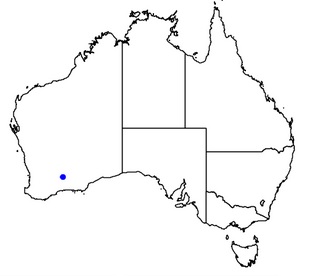Acacia gibsonii
Contents
General Plant Info
Acacia gibsonii is a new rare species, endemic to South-West Western Australia. It is distinctively short, 0.5(-1) m tall and to 1.5 m diam, having 3-nerved phyllodes and short spikes, with affinities to Acacia incongesta.
The botanical name honours Dr Neil Gibson, Principal Research Scientist with the Department of Parks and Wildlife, who co-discovered (with Michael Lyons) this species in September 1994
Acacia gibsonii is listed as Priority One under DEC Conservation Codes for Western Australian Flora, as Acacia sp. Lake Johnson (N. Gibson & M. Lyons 1959) (Smith 2012).
Geographic distribution
The species is known from a geographically very restricted area of greenstone hills between Norseman and Hyden
Beard’s Provinces: Eremaean Province.
IBRA Regions: Coolgardie.
IBRA Subregions: Southern Cross.
Local Government Areas (LGAs): Dundas
Identification
Branchlets terete, obscurely ribbed, reddish brown aging light grey and slightly roughened, sparsely to moderately muriculate by minute, red-brown, glandular trichomes at extremities, glabrous on mature branchlets.
Stipules ±persistent, triangular, inconspicuous, 0.5–0.8 mm long, scarious.
Phyllodes oblong to oblong-elliptic or oblong-obovate or sometimes slightly sigmoid, 6–13 mm long, 1.5–3 mm wide, sometimes crowded on very short branchlets which commonly grow out, straight or very shallowly recurved, ascending to erect with some ±patent, glabrous except for minute, red-brown, glandular trichomes on the normally sparsely tuberculate main nerves and margins of most phyllodes, green; prominently 3-nerved on each face, the nerves raised (at least when dry) and widely spaced, sometimes (on widest phyllodes) with a less pronounced, occasionally sparingly branched nerve between the main nerves; apex excentrically mucronate, the mucro 0.4–0.6 mm long, hard, ±pungent and dark brown; base equal or unequal; pulvinus 0.3–0.5 mm long, resinous or not resinous. Gland obscure, situated on upper margin of phyllode 0.5–1 mm above the pulvinus, circular, minute.
Inflorescences simple, single within axil of phyllodes; spikes 5–7 mm long (dry), golden, flowers rather densely arranged within spikes; receptacles moderately hirsutulous; peduncles to 1 mm long, appressed puberulous; basal peduncular bract single, persistent, ovate, shallowly concave, brown, fimbriolate. Bracteoles spathulate, 0.6–0.7 mm long, claws narrowly oblong, laminae widely ovate, 0.4–0.5 mm wide, aging brown and ciliolate. Flowers 4-merous; sepals very shortly united at base, membranous, narrowly oblong or spathulate,⅔ length of petals, sparsely hairy; petals 1–1.2 mm long, glabrous or sometimes sub-glabrous, nerveless.
Pod (only one seen) ±tightly 1½ coiled, prominently rounded over seeds but not or scarcely constricted between them, c. 12 mm long (unexpanded length), 2.5 mm wide, thinly coriaceous, glabrous, mid- to dark-brown, finely longitudinally nerved, marginal nerve not or scarcely thickened.
Seeds longitudinal in pods, obloid, 2–2.5 mm long, 1.5 mm wide, compressed (c. 1.3 mm thick), black, shiny; areole ‘u’-shaped, open towards the hilum, c. 0.5 × 0.3 mm; pleurogram obscure; funicle filiform, expanded into a conspicuous, pileiform, creamy white aril that is only slightly shorter than the seed
Alkaloid content
Other uses
Extraction
Cultivation
Suppliers
Links
http://florabase.dpaw.wa.gov.au/science/nuytsia/678.pdf
http://florabase.dpaw.wa.gov.au/browse/profile/43160
